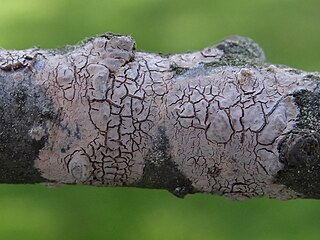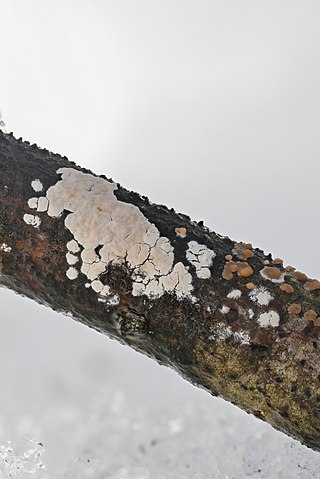Ceratobasidium ochroleucum is a species of fungus in the family Ceratobasidiaceae. Basidiocarps are effused and web-like and were originally described from Brazil, causing a thread blight of apple and quince trees. The fungus was subsequently reported as a leaf disease on orchard crops in North America, but since descriptions of Ceratobasidium orchroleucum vary considerably and no type specimen exists, its identity remains unclear. Roberts (1999) considered it a "nomen dubium".

Ceratobasidium cornigerum is a species of fungus in the order Cantharellales. Basidiocarps are thin, spread on the substrate out like a film (effused) and web-like. An anamorphic state is frequently obtained when isolates are cultured. Ceratobasidium cornigerum is saprotrophic, but is also a facultative plant pathogen, causing a number of economically important crop diseases, and an orchid endomycorrhizal associate. The species is genetically diverse and is sometimes treated as a complex of closely related taxa. DNA research shows the species actually belongs within the genus Rhizoctonia.
Corticium penicillatum is a species of fungus in the class Agaricomycetes. It is a corticioid fungus and a plant pathogen, the causal agent of coconut thread blight, a leaf disease of coconut palms. The species was originally described from Papua New Guinea in 1925 and has since been reported from Vanuatu, Fiji, and the Solomon Islands. Corticium penicillatum has never been redescribed or reviewed and is unlikely to be a species of Corticium in the modern sense.
Corticium theae is fungus that is a plant pathogen.

Peniophora cinerea is a species of fungus in the family Peniophoraceae. It is a plant pathogen infecting black walnut.
Rhizochaete is a plant pathogen infecting planes, beeches, pines, oaks and other trees.
Granulobasidium vellereum is a species of fungus in the family Cyphellaceae. A plant pathogen associated with white rot of angiospermous logs, slash, and living trees, it has been found in Sweden and Denmark, and in North America. Originally described as Corticium vellereum in 1885, it was transferred to the genus Granulobasidium by Walter Jülich in 1979.

Corticium roseum is a species of fungus in the family Corticiaceae. Basidiocarps are effused, smooth, corticioid, and pink. The species has a wide, north and south temperate distribution and in Europe is typically found on dead, attached branches of Salix and Populus.

Terana caerulea, commonly known as the cobalt crust fungus or velvet blue spread, is a saprobic crust fungus in the family Phanerochaetaceae. Usually found in warm, damp hardwood forests on the undersides of fallen logs and branches of deciduous trees, this unique fungus has been described as "blue velvet on a stick". This species was chosen as fungus of the year for 2009 by the German Mycological Society.

Peniophora is a genus of fungi which are plant pathogens. Members of the genus belong to the class Agaricomycetes, order Russulales, and family Peniophoraceae. The genus is widespread, and contains 62 species. The species of Peniophora are resupinate, or crust-like, and are described as corticioid. A number of its members are parasitised by other fungi. For example, Tremella mesenterica is a parasite to several species of Peniophora.

Corticium is a genus of fungi in the family Corticiaceae. Basidiocarps are effused, corticioid, smooth, and grow on dead wood. One species, C. silviae, is lichenicolous. The genus was formerly used in a very wide sense for almost any effused corticioid fungi.

The corticioid fungi are a group of fungi in the Basidiomycota typically having effused, smooth basidiocarps that are formed on the undersides of dead tree trunks or branches. They are sometimes colloquially called crust fungi or patch fungi. Originally such fungi were referred to the genus Corticium and subsequently to the family Corticiaceae, but it is now known that all corticioid species are not necessarily closely related. The fact that they look similar is an example of convergent evolution. Since they are often studied as a group, it is convenient to retain the informal (non-taxonomic) name of "corticioid fungi" and this term is frequently used in research papers and other texts.

Ceratobasidium is a genus of fungi in the order Cantharellales. Basidiocarps are effused and the genus is sometimes grouped among the corticioid fungi, though species also retain features of the heterobasidiomycetes. Anamorphic forms were formerly referred to the genus Ceratorhiza, but this is now considered a synonym of Rhizoctonia. Ceratobasidium species, excluding the type, are also now considered synonymous with Rhizoctonia and some species have been transferred to the latter genus. Species are saprotrophic, but several are also facultative plant pathogens, causing a number of commercially important crop diseases. Some are also endomycorrhizal associates of orchids.
Crustodontia is a fungal genus of uncertain familial placement in the order Polyporales. The genus was circumscribed in 2005 to contain the crust fungus Crustodontia chrysocreas. This species was originally described as Corticium chrysocreas by Miles Berkeley and Moses Ashley Curtis in 1873. Their description was as follows: "Subiculum bright yellow, thin; hymenium immarginate pallid, or yellow tinged with tawny." Crustodontia has a monomitic hyphal system, meaning it contains only generative hyphae, and these hyphae have clamp connections.
Cerocorticium molle is a species of crust fungus in the family Meruliaceae.

Sistotrema brinkmannii, a resupinate wood-rotting basidiomycete, is a fungus found in soil, moss, debris, rotten woods as well as woods including seedling roots of Pinus banksiana Lamb. and ectomycorrhizae. No health issues caused by this fungus in human and animals have been reported although it is causative of brown rot. This fungus grows rapidly on malt extract agar (MEA), forming white mats with a faint sweet odour. It is commonly called "chain chlamydospore fungus" because bulbils are formed by chains of its cells that resemble chlamydospores. The basidia of this fungus are urniform and usually possess 6-8 sterigmata, and the spores are smooth and slightly curved.

Amphinema byssoides is a species of corticioid fungus known to form mycorrhizal relationships with spruce trees.

Botryobasidium is a genus of corticioid fungi belonging to the order Cantharellales. Basidiocarps are ephemeral and typically form thin, web-like, white to cream, effused patches on the underside of fallen branches, logs, and leaf litter. Several species form anamorphs producing chlamydospores. All species are wood- or litter-rotting saprotrophs and the genus has a worldwide distribution.
Corticium is a genus of sponges in the order Homosclerophorida first described by Eduard Oscar Schmidt in 1862.

Sebacina sparassoidea, the white coral jelly fungus, is a species of fungus in the family Sebacinaceae. Its coral-like basidiocarps are typically a yellowish off-white and have a gelatinous and elastic texture. Found in eastern North America, in humid environments amongst rotting logs of deciduous trees, particularly oaks, it is often observed growing throughout the months of August to September.








